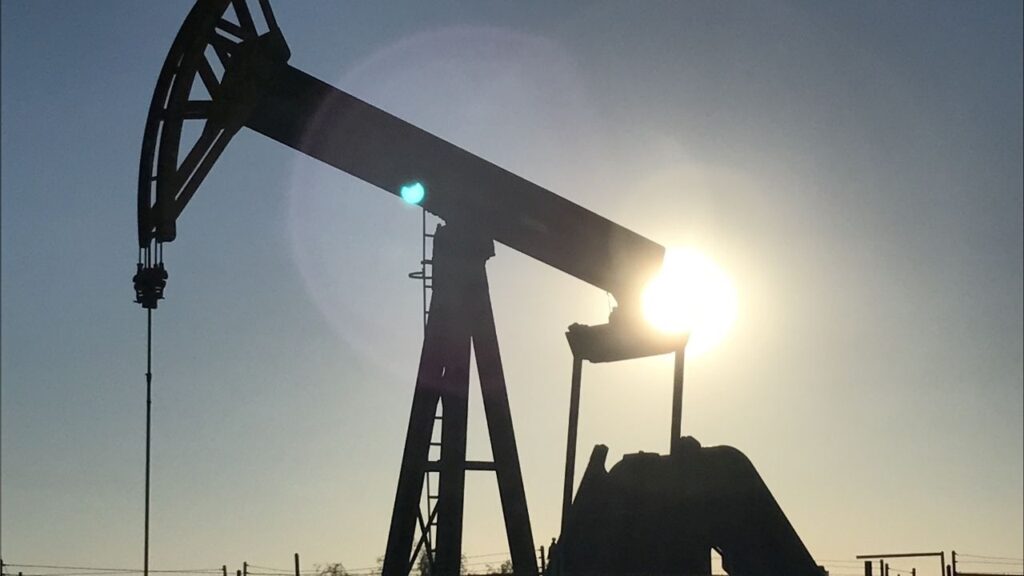Adrian De La Cruz fills his work truck with diesel gas at a station in west Fresno on May 7, 2024. (CalMatters/Larry Valenzuela)

- Californians pay the highest gas prices in the US, averaging $5.34 per gallon.
- Gas prices in the state have increased by 55 cents per gallon from a year ago.
- In 2023, California had 14 refineries compared to 43 in 1982.
Share
|
Getting your Trinity Audio player ready...
|
Californians pay more at the pump than residents of any other state — an average of $5.34 a gallon for regular unleaded, compared to the national average of $3.64, according to AAA. And in some counties, the sticker shock is even worse — $6.80 in Alpine, $6.29 in Mono and $5.85 in Humboldt, for example.

Lynn La
CalMatters
Statewide, gas prices have jumped 55 cents a gallon from this time a year ago.
It’s also a little more than a year ago when Gov. Gavin Newsom’s plan to crack down on windfall oil profits became law. So what’s up?
Tuesday, the Senate energy committee asked California Energy Commission officials that very question. Citing the “crippling” effect high gas prices have on low-income Californians and commuters, legislators wanted to know if the law’s increased reporting requirements on oil companies have helped the commission determine whether to recommend capping oil profits and penalizing oil companies that exceed the cap. Any recommendation isn’t expected until later this year.
“We want to have the confidence that the solutions will bring relief to Californians at the pump are real and not just aspirational,” said Sen. Steven Bradford, an Inglewood Democrat and chairperson of the committee. “Far too often, we shoot first and ask questions later.”
Though the commission is still gathering data, what it and its new watchdog division found so far was that the three times gas prices notably spiked in the last five years (in October 2019, October 2022 and September 2023), oil company profits rose. Environmental fees and state and federal taxes, however, remained relatively flat during that periods.
“Price spikes are profit spikes for the oil industry,” said Tai Milder, director of the Division of Petroleum Market Oversight.
Related Story: California Reports the First Increase in Groundwater Supplies in 4 Years
The Volatility of Gas Prices
What causes gas prices to be so volatile? One reason is the price of crude oil, which can be swung by global events such as the wars in Ukraine and Gaza. These wholesales prices, in turn, impact retail prices. But while both typically rise in tandem, they do not fall together — when wholesale prices drop, pump prices are often slow to follow.
Siva Gunda, vice chairperson of the energy commission, describes the pattern as “up like a rocket but down like a feather.”
Still, Gunda said that there is no clear evidence that oil companies are engaging in price gouging, but that there is also no industry incentive to ease price spikes.
“None of the industry in our good-faith discussions disputes that profits go up a lot. So who’s to decide how high you can go during those times?” said Gunda. “That’s what we’re trying to think through. Given that this is such an important public benefit, how do we ensure that there’s a cutoff?”
At the hearing, Catherine Reheis-Boyd, president and chief executive officer of Western States Petroleum Association, pushed back against caps and penalties. She told CalMatters that they wouldn’t reduce prices, but have “the absolute opposite effect.” To avoid incurring penalties on profits, companies will restrict supply, which will drive up costs.
California Down to 14 Refineries From 42 in 1982
“It’s two to three times more expensive to run a refinery in California than anywhere else in the world. It comes to a point where it becomes uneconomic,” Reheis-Boyd said. In 2023, California had 14 refineries compared to 43 in 1982.
Instead, Reheis-Boyd argues that legislators should look into investing more into the oil supply chain to increase supply, such as lifting restrictions on the production of crude oil in California.
Some reasons for higher prices are built into the calendar.
Service stations in California have already switched to the more expensive summer fuel blend, formulated to reduce ozone emissions — in Southern California on Feb. 1, and in Northern California on March 1, according to the energy commission. Last year, Newsom pushed to go back to winter fuel sooner than the usual Oct. 31 to help bring down prices.
And on July 1, the state’s excise gas tax will increase by 1.9 cents to 59.6 cents a gallon to keep up with inflation. The tax on diesel fuel will rise by 1.3 cents to 45.4 cents a gallon.
About the Author
Lynn La is the newsletter writer for CalMatters, focusing on California’s top political, policy and Capitol stories every weekday. She produces and curates WhatMatters, CalMatters’ flagship daily newsletter with more than 150,000 subscribers. Lynn is based in the Bay Area. She graduated from UC Davis and the Columbia University Graduate School of Journalism.
About CalMatters
CalMatters is a nonprofit, nonpartisan newsroom committed to explaining California policy and politics.



















